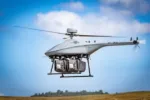SATIM and ICEYE have launched a new artificial intelligence-powered tool designed to automate the analysis of synthetic aperture radar (SAR) imagery for defense and intelligence applications. The system combines SATIM’s AI-based automatic target recognition (ATR) engine with ICEYE’s high-revisit SAR satellite constellation to deliver near-real-time object detection capabilities in all-weather conditions.
AI Meets Persistent SAR for Enhanced ISR
The collaboration between Polish defense-tech company SATIM and Finnish-NewSpace firm ICEYE brings together two key technologies in modern ISR (intelligence, surveillance, reconnaissance): persistent synthetic aperture radar imaging and artificial intelligence-based analytics. By integrating SATIM’s proprietary ATR algorithms with ICEYE’s commercial SAR data stream, the system enables users to automatically identify military objects such as aircraft, naval vessels, ground vehicles, or infrastructure—regardless of cloud cover or time of day.
ICEYE operates one of the world’s largest commercial SAR satellite constellations with over 20 satellites in low Earth orbit (LEO), offering revisit rates as short as several hours globally. This high temporal resolution is critical for change detection and monitoring mobile or concealed targets. Meanwhile, SATIM has developed advanced machine learning models trained on extensive SAR datasets to perform object classification directly on radar images.
Operational Use Cases in Defense Intelligence
The joint solution is tailored for defense customers requiring rapid situational awareness in denied or degraded environments. Key use cases include:
- Automated Order-of-Battle Assessment: Identifying concentrations of armored vehicles or artillery systems across wide areas without manual image review.
- Maritime Domain Awareness: Detecting naval movements even under cloud cover or at night—where optical satellites fail.
- Tactical Change Detection: Monitoring airbases or staging areas for signs of mobilization or infrastructure buildup.
SATIM claims its AI engine can detect over 60 classes of military objects from a single-pass SAR image with minimal false positives. The system is sensor-agnostic but optimized for integration with ICEYE’s stripmap and spotlight mode imagery at resolutions down to 0.25 meters.
SAR Advantages Over Optical Systems
Synthetic aperture radar provides unique advantages over electro-optical (EO) sensors in contested environments. Unlike EO satellites that rely on sunlight and clear skies, SAR systems emit their own microwave signals and can penetrate clouds, smoke, camouflage nets, and even some foliage types depending on frequency band (typically X-band for tactical resolution).
This makes SAR particularly valuable in regions like Eastern Europe or Southeast Asia where persistent cloud cover limits EO utility. Moreover, the ability to task satellites at night gives commanders a true 24/7 ISR capability—a critical factor in time-sensitive targeting cycles.
The fusion of AI with radar data further reduces analyst workload by automating first-pass exploitation (FPE), allowing human operators to focus on confirmation and interpretation rather than initial detection tasks.
Platform Architecture and Data Delivery
The integrated platform allows users—either defense agencies or allied contractors—to access processed results via secure web interfaces or API endpoints. According to both companies’ statements reviewed by MiliVox Editorial Engine:
- ICEYE provides raw or pre-processed Level-1/Level-2 SAR imagery, including geolocation metadata.
- SATIM ingests this data into its cloud-based ATR engine, which applies convolutional neural networks (CNNs) trained on curated military object libraries.
- The output includes annotated images with object classifications, confidence scores per detection event, timestamps, coordinates (WGS84), and optional change overlays if historical data exists.
This modular architecture supports integration into existing C4ISR platforms via STANAG-compatible formats such as GeoTIFF overlays or NATO APP-6 symbology layers for map-based visualization tools like FalconView or ATAK.
Market Positioning Amid Growing Demand for Automated GEOINT
The launch comes amid rising demand among NATO members and allied nations for automated geospatial intelligence tools that reduce reliance on scarce human analysts while accelerating decision timelines. With Russia’s invasion of Ukraine highlighting the importance of persistent ISR—including commercial sources—the defense sector has increasingly turned toward dual-use space assets like those operated by ICEYE.
In fact, Ukraine has reportedly used commercial SAR from multiple vendors—including Capella Space and ICEYE—for BDA (battle damage assessment), artillery cueing support, and tracking Russian logistics hubs under concealment conditions. In August 2022, a Ukrainian charity purchased access to an entire ICEYE satellite dedicated exclusively to Ukrainian MOD tasking—a first-of-its-kind model that may shape future government-commercial partnerships in ISR procurement strategy.
Future Development Roadmap
SATIM plans to expand its object classification library beyond current military platforms into hybrid civil-military categories such as logistics trucks or dual-use infrastructure nodes like bridges and rail yards—key targets in modern hybrid warfare scenarios. Furthermore:
- A planned upgrade will introduce multi-temporal analysis using recurrent neural networks (RNNs) to detect patterns over time rather than static snapshots alone.
- A mobile-accessible interface is under development aimed at tactical-level users operating with limited bandwidth field terminals.
- SATIM also intends to support additional sensor inputs including P-band interferometric data once available via future LEO platforms from European partners like Airbus Defence & Space.
Conclusion: Toward Machine-Speed GEOINT Fusion
The SATIM–ICEYE partnership reflects a broader trend toward machine-speed intelligence processing where AI augments—not replaces—human analysts by surfacing anomalies faster than traditional workflows allow. As adversaries adopt more sophisticated denial-and-deception tactics—including decoys, camouflage nets, electronic warfare jamming—the ability to fuse resilient sensing modalities like SAR with intelligent automation will be decisive in maintaining information superiority across domains.









